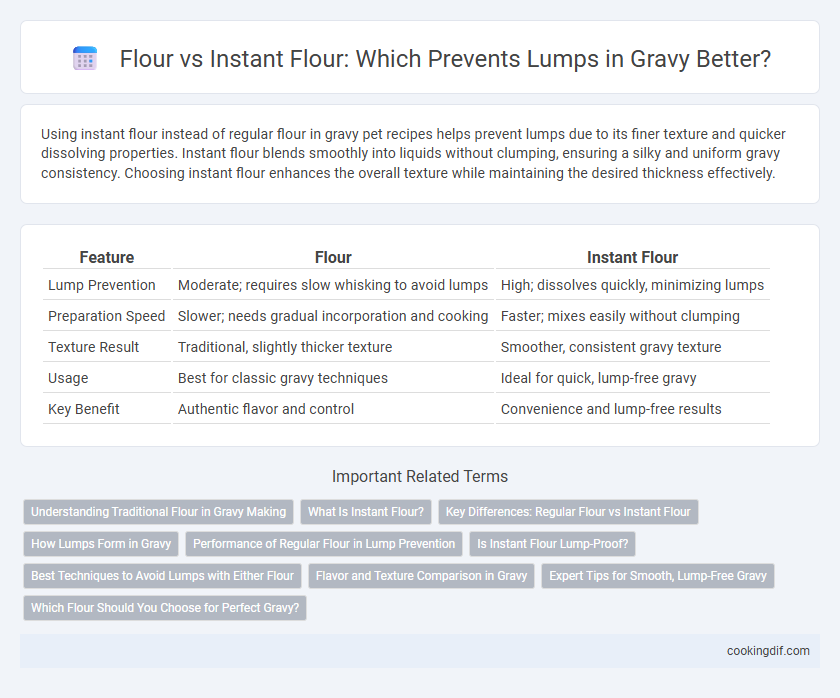Using instant flour instead of regular flour in gravy pet recipes helps prevent lumps due to its finer texture and quicker dissolving properties. Instant flour blends smoothly into liquids without clumping, ensuring a silky and uniform gravy consistency. Choosing instant flour enhances the overall texture while maintaining the desired thickness effectively.
Table of Comparison
| Feature | Flour | Instant Flour |
|---|---|---|
| Lump Prevention | Moderate; requires slow whisking to avoid lumps | High; dissolves quickly, minimizing lumps |
| Preparation Speed | Slower; needs gradual incorporation and cooking | Faster; mixes easily without clumping |
| Texture Result | Traditional, slightly thicker texture | Smoother, consistent gravy texture |
| Usage | Best for classic gravy techniques | Ideal for quick, lump-free gravy |
| Key Benefit | Authentic flavor and control | Convenience and lump-free results |
Understanding Traditional Flour in Gravy Making
Traditional flour, typically all-purpose flour, plays a crucial role in gravy making by providing a smooth texture and thickening consistency when properly cooked. Unlike instant flour, which dissolves quickly but can lead to lumps if not mixed thoroughly, traditional flour requires gradual incorporation and adequate cooking time to fully gelatinize starch granules. Mastering the technique of slow blending and constant stirring ensures lump-free gravy with a rich, velvety finish.
What Is Instant Flour?
Instant flour is specially processed to dissolve quickly in liquid, preventing clumps in gravy and sauces. Unlike regular flour, instant flour is pre-cooked and finely ground, allowing it to thicken mixtures smoothly without forming lumps. Using instant flour ensures a consistent texture and saves time during cooking, making it ideal for lump-free gravy.
Key Differences: Regular Flour vs Instant Flour
Regular flour requires cooking to eliminate its raw taste and activate thickening properties, making it ideal for gravies that need simmering to prevent lumps. Instant flour, pre-cooked and finely milled, thickens sauces quickly without needing prolonged heat, reducing the risk of clumping during preparation. Key differences lie in texture and preparation time, where regular flour offers more control over consistency, while instant flour provides convenience but can sometimes lead to a slightly different mouthfeel in gravy.
How Lumps Form in Gravy
Lumps in gravy form when starch granules from flour clump together due to uneven mixing or sudden temperature changes. Regular flour requires gradual incorporation with fat or liquid to prevent these starch clusters, while instant flour is pre-gelatinized, dissolving smoothly and reducing the risk of lumps. Proper stirring and the choice of flour type directly influence the smoothness and texture of the finished gravy.
Performance of Regular Flour in Lump Prevention
Regular flour exhibits superior performance in lump prevention when making gravy due to its higher starch content and slower hydration rate, which allows more controlled thickening. Its granular structure helps absorb liquids gradually, reducing the formation of clumps during the cooking process. Many chefs prefer regular flour for smooth, consistent gravy texture, as it provides better control over viscosity compared to instant flour.
Is Instant Flour Lump-Proof?
Instant flour is specifically processed to dissolve quickly and smoothly in liquids, making it a superior choice for lump-free gravy compared to regular flour. Its pre-gelatinized starch structure allows for seamless incorporation without clumping, ensuring a consistent texture. Chefs often prefer instant flour in gravy recipes to achieve a smooth, professional finish with minimal effort.
Best Techniques to Avoid Lumps with Either Flour
Using either all-purpose flour or instant flour effectively prevents lumps in gravy by properly incorporating them into a roux or slurry before adding liquid. Whisking continuously and gradually adding the liquid ensures a smooth consistency, while cooking over medium heat allows the starches to fully activate and thicken evenly. For instant flour, which dissolves faster, sifting it into cold liquid before heating helps maintain a lump-free texture in gravity-rich sauces.
Flavor and Texture Comparison in Gravy
Flour and instant flour differ significantly in their impact on gravy's flavor and texture, with traditional flour offering a richer, more authentic taste and a smoother, silkier texture. Instant flour tends to thicken quickly but can sometimes result in a slightly starchy or chalky flavor, compromising the gravy's overall mouthfeel. For lump prevention, whisking traditional flour with a small amount of cold liquid before integrating it ensures a more consistent, velvety texture without sacrificing depth of flavor.
Expert Tips for Smooth, Lump-Free Gravy
Using instant flour instead of regular flour significantly reduces the risk of lumps in gravy due to its finer texture and faster dissolving properties. Mixing instant flour with cold water before adding it to hot liquids ensures even dispersion, resulting in a smooth, creamy consistency. Experts recommend whisking the gravy constantly while adding the thickener to prevent clumping and achieve professional-grade, lump-free results.
Which Flour Should You Choose for Perfect Gravy?
Choosing the right flour for perfect gravy depends on lump prevention and texture. Instant flour is pre-cooked and dissolves smoothly, minimizing lumps, while regular flour requires whisking and careful cooking to avoid clumps. For consistent, silky gravy, instant flour is often preferred due to its ease of use and reliable lump-free results.
Flour vs Instant Flour for lump prevention Infographic

 cookingdif.com
cookingdif.com